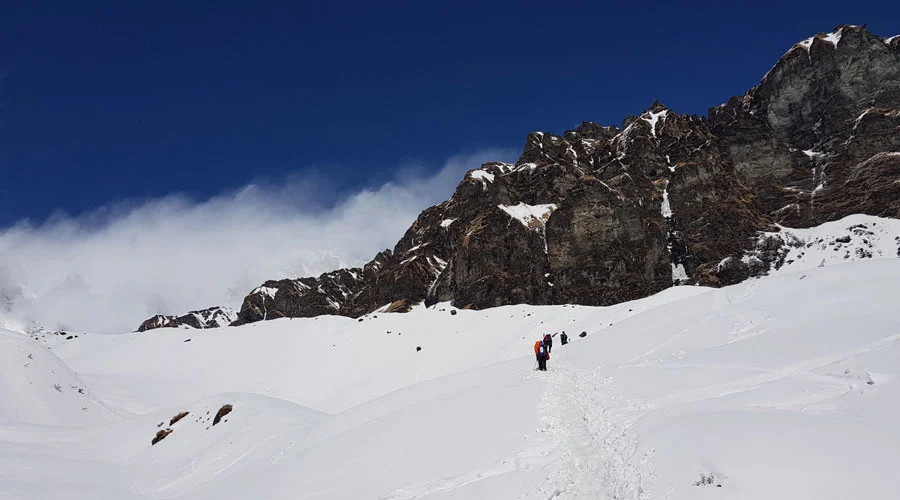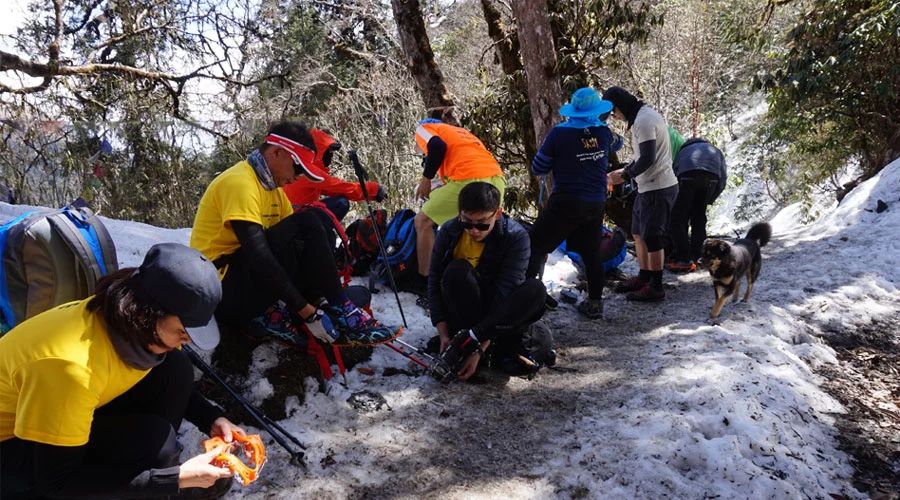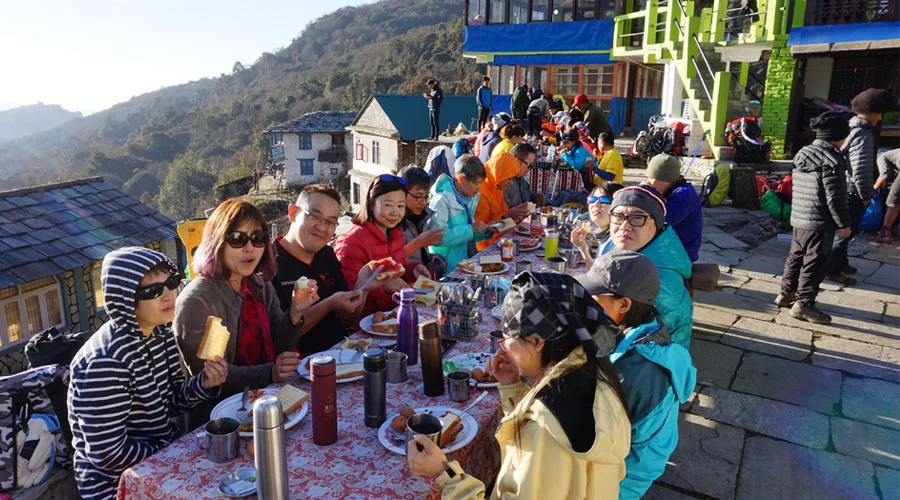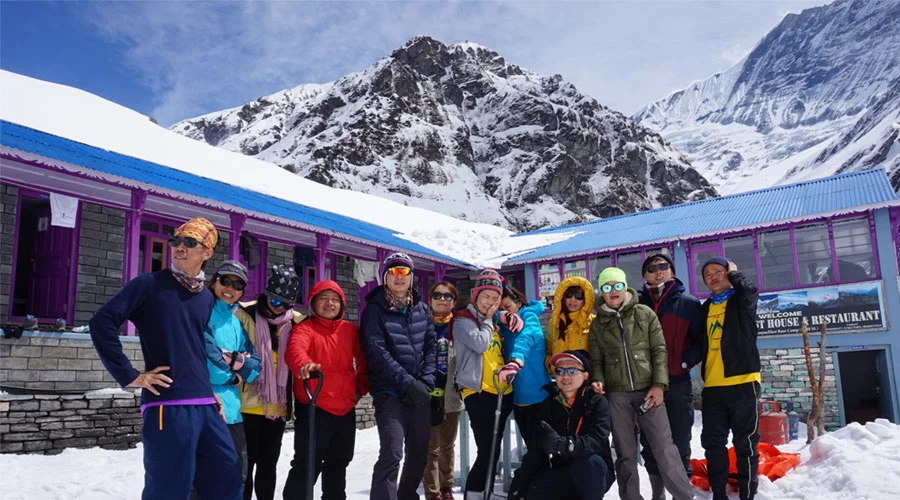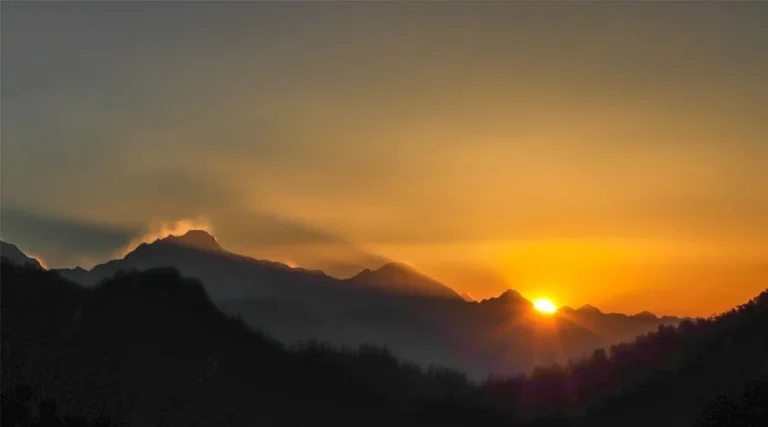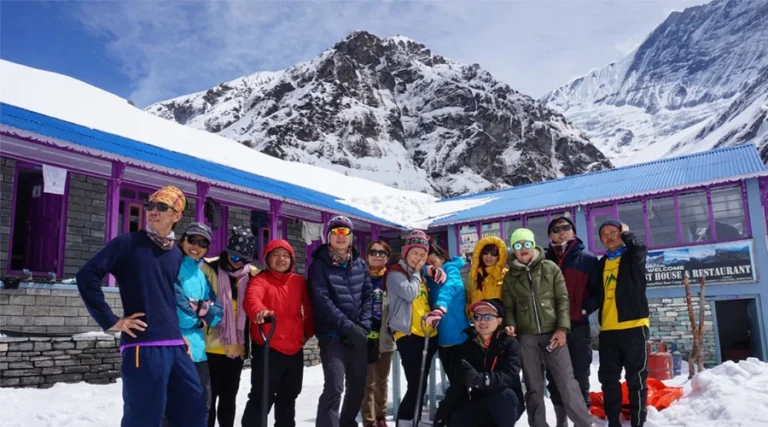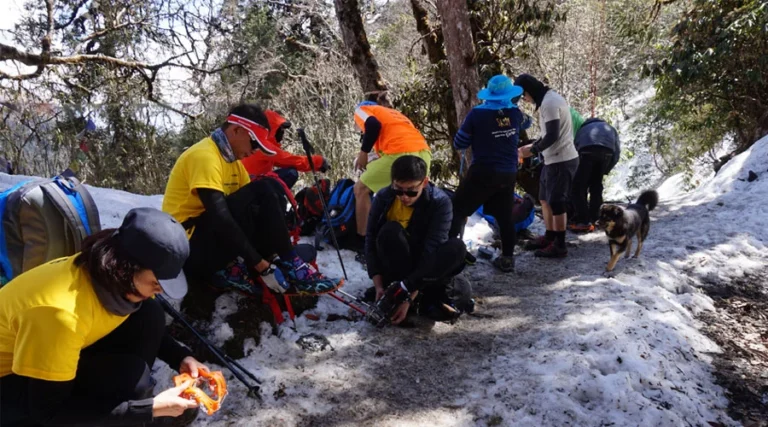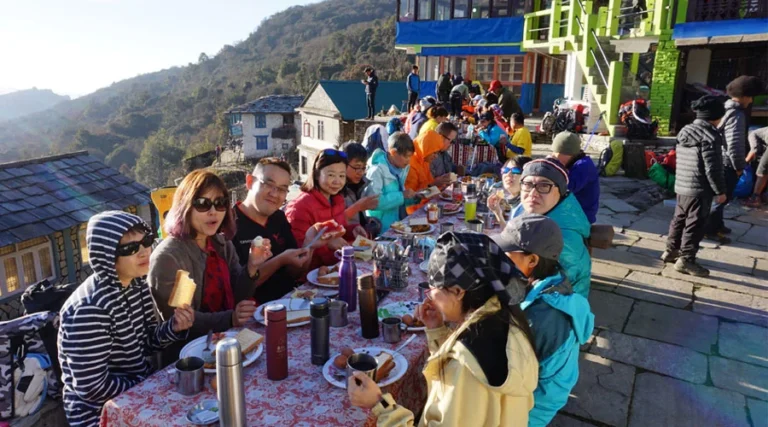Annapurna Base Camp Trek
-

Trip Duration 12 Days
-

Max, Altitude 4,130 meters
-

Type Standard
-

Best Season Sept - May
-

Meals Included
-

Accommodation Guest House
-

Activity Trekking
-

Difficulty Moderate
- Surrounding views of the famous Annapurna and Dhaulagiri mountains.
- Strolling along lovely forests full of rhododendron flowers in the spring season.
- Reaching rivers and watching waterfalls from the path.
- Getting to know local people in small communities and discovering their way of life in Ghandruk and Chhomrong.
- Viewing the famous Machhapuchare (Fishtail) mountain, whose shape is truly striking.
- At Annapurna Base Camp(4130 meters), you are surrounded by huge snowy mountains.
- Crossing over long bridges that hang thousands of feet from the ground at Jhinu Suspension Bridge.
- Seeing bird and animal species that are found only in the mountains.
- Watching the dawn and the dusk fill the sky with beautiful colours.
- Experiencing the warmth of natural hot springs after ending a strenuous day.
- Using teahouses as places to warm up with nice meals and relax.
- Experiencing something exciting that may be tough but is very satisfying and stays with you for a long time.
Annapurna Base Camp Trek is one of Nepal’s most popular trekking destinations. It surprises visitors with its panoramic views of the Himalayan range, an opportunity to experience local culture, and the flavour of an adventurous trek.
Annapurna Base Camp is at 4,130 meters on the lap of Mount Annapurna (8,091m), the 10th tallest mountain in the world.
Annapurna Base Camp Trek Overview
Annapurna Base Camp Trek starts in the enchanting city of Pokhara and passes through the fine villages of Ghandruk, Chhomrong, and Bamboo. In the middle of the trek, you will chirp through the terraced fields, Rhododendron forests, and Modi Khola.
The journey will include getting to the Annapurna Base Camp at the foot of giants like Annapurna I, Machhapuchhre (Fishtail), Hiuchuli, and Gangapurna. The view is even better in the sunrise, making the tiring hike all worth it when you get here.
The Annapurna Base Camp Trek is moderate, meaning it can be enjoyed by people of all fitness levels, from inexperienced to experienced. However, it requires steep climbing, slippery rocks, and uneven surfaces.
ABC Trekking is best in spring (March) and autumn (September – November) because of the clear weather, meoderate temperatures, and beautiful surroundings.
It is also possible, especially for those searching for solitude, to make winter treks from December through February, but it will be very cold on the hills.
Other attractions include a natural hot spring at Jhinu Danda, where you can dip to soften muscles and have an opportunity to witness floral and faunal variety.
Ranging from waterfalls at extraordinary locations to high mountains blushed with snow everywhere, one gets to see a new face of nature every day.
ABC Trek is about Nature, adventures, breathtaking culture, and charming people. Whether you are a nature lover, a culture vulture, or an adventurer, prepare to be blown away by an ABC trek in the heart of the Himalayas, Nepal.
How long is the Annapurna Base Camp Trek?
Due to the Annapurna Base Camp Trek starting point and trekking speed differences, the length of the Annapurna Base Camp (ABC) trek is flexible. Typically, the total duration of ABC Trek is completed within 7 to 14 days.
But, according to the Annapurna Base Camp Trek package from Himalayan Trekking and Tours, the trip takes 12 days. You will spend 12 days on the itinerary: arriving in Nepal, acclimatizing, trekking and going back to Pokhara for the night.
Annapurna Base Camp Trekking Route
The ABC Trek Route begins from Pokhara; the journey goes through many a village, which includes Naya Pul, Ghandruk, Chhomrong, Bamboo, Dovan and Deurali.
From the village of Deurali, trekkers head out to the Machapuchare Base Camp (MBC), from where it is on to the Annapurna Base Camp, which is at 4,130 meters.
The trail goes through forests, village communities, rivers and waterfalls, which in turn present you with great views of Annapurna and other mountains.
Also, the ABC Trek route is very well marked and what with the large number of annual trekkers who use it, that which pertains to navigation is made very easy.
Annapurna Base Camp Trek Difficulty
Annapurna Base Camp Trek difficulty is not an extremely challenging trekking route. It is perfect for beginners with reasonable fitness levels and experienced trekkers. It is not technical climbing, but the long walking hours and stiff climbs may sometimes be challenging.
Annapurna Base Camp Trek Distance is 115 kilometres long and 4,130 meters above sea level, so altitude sickness may occur. Trekkers need to acclimatize, drink a lot of water, and not rush to avoid sickness.
Daily trekking lasts 5-7 hours and involves walking on rocky paths, stairs, and uneven surfaces. Some of the most strenuous parts of the walk, such as the climb to Chhomrong and the base camp of Machhapuchhre, are physically demanding but not very challenging if one prepares well.
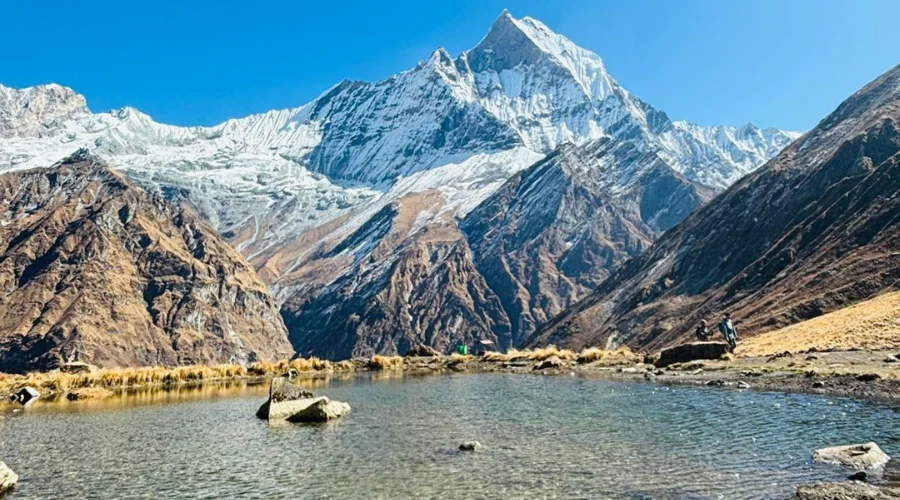
Another factor is the weather, which can make the difficulty easier or harder. The optimal period is Spring and Autumn, March, May and September November, respectively, due to good weather for trekking.
Winter lasts from December to February, with snow and freezing conditions, and monsoon season lasts from June to August, with slippery, leech-infested trails.
Fitness and training such as cardio, strength training, and good planning might make the trek more enjoyable. With a strong mindset and determination, ABC Trek provides fantastic scenery and the feeling of having accomplished a remarkable feat.
Annapurna Base Camp Trek Weather and Temperature
The climate of Annapurna Base Camp (ABC) trek varies by season, which is why it is advised to plan your trip in detail.
| Season | Months | Day Temperature | Night Temperature | Weather Highlights |
| Spring | March – May | 10°C to 20°C | 0°C to 5°C | Clear skies, rhododendron blooms, great mountain views, ideal for trekking. |
| Summer/ Monsoon | June – August | 15°C to 25°C | 5°C to 10°C | Heavy rain, slippery trails, cloudy skies, leeches on the trail, poor visibility. |
| Autumn / Fall | September – November | 10°C to 20°C | 0°C to 5°C | Best trekking season, dry and clear weather, stunning mountain views, crowded trails. |
| Winter | December – February | 5°C to 10°C | -10°C to -5°C | Very cold, snowfall at higher altitudes, fewer trekkers, risk of avalanches. |
In spring, which is between March and May, the weather usually breaks out to fine days, and you see the rhododendron flowers along with the beautiful mountain views.
The Annapurna Base Camp weather can change quickly, so check the forecast and pack appropriate clothing for the various types of weather.
Tips for Annapurna Base Camp
- Get in shape before you start by doing physical exercises.
- Travel with only your important gear on board.
- Put on items you can add or remove based on the weather.
- Be sure to drink about 3–4 litres of water every day.
- Walk calmly so that your body does not get exhausted.
- Spend time at high altitude to prepare and notice if you feel altitude sickness.
- Use worn-in trekking boots that will give you good traction as you climb.
- Always have a small first-aid set, including treatments for altitude.
- Take cash with you because there are no ATMs where you will be hiking
- Make sure you have all the necessary permits (ACAP and TIMS) before you start the trek.
Annapurna Base Camp Trek Itinerary 5 Days
You can complete the Annapurna Base Camp (ABC) trek in only 5 days, which is a fast option if you are fit.
Trekkers need to walk for several hours without enough time to adjust. See the following ABC trek itinerary for a 5-day experience:
Annapurna Base Camp Trek 5 Days Itinerary
Day 1: Drive from Pokhara to Jhinu Danda and Trek to Chhomrong
Day 2: Chhomrong to Himalaya
Day 3: Himalaya to Annapurna Base Camp via Machhapuchare Base Camp
Day 4: Trek back from ABC to Sinuwa
Day 5: Trek to Jhinu Danda and drive back to Pokhara
Short Itinerary
Itinerary of Annapurna Base Camp Trek
At Tribhuvan International Airport in Kathmandu, you will meet our representative, who will then take you to your hotel in Thamel.
During the day, you will mostly be at rest and acclimatizing. In Thamel, you will find many shops, cafes and restaurants to while away the evenings at.
A briefing with your guide will take place later, which goes into detail about the trek. We will cover the route, safety measures, and weather patterns during the hike and answer any questions you may have.
It is a good idea to go over what equipment you have and purchase any which you may still require. As you won’t be going today, use the time to rest and save your energy.
- 3 Star hotel in Kathmandu
- No Meal Included
After breakfast at the hotel, take a private bus to Pokhara. The drive takes about 6-7 hours. Pokhara is a beautiful valley on the banks of Phewa Lake.
You will cover a distance of 200 km, which takes between 6 to 7 hours to complete by either bus or private vehicle. The road takes you through the green hills, and we stay by the Trishuli River for the most part.
We pass through small towns, and in that which is in between the cities, you will see the beautiful rural setting and life in Nepal. Upon arrival at our accommodation, you will have time to rest.
In Pokhara, which is so beautiful for its lakeside view, go for a walk around Phewa Lake or the Peace Pagoda. There is little to no walking, which also serves as a break before your hike at a lower elevation.
Overnight at a hotel.
- 3 Star Hotel in Pokhara
- Breakfast Included
Today, you will head out of Pokhara in your car, which will take you to Nayapul; that is where the trek begins. Usually, the travel time is 1.5 hours on the mountain road.
From the start in Nayapul, you go by the Modi River and pass through Birethanti, which has great views of green farmland. Then, the trail goes up to Tikhedhunga, where we stop for lunch.
The long climb of the day is what it takes to do some 3,200 stairs, which in turn will bring you to Ulleri village. Going up the hill, we gain almost one thousand meters in elevation, which may be very tiring.
The trail is very well maintained, which in turn allows visitors to see the nearby forests and farms. Upon arrival in Ulleri, you will have dinner and then head to the teahouse for the night.
Overnight at a Guesthouse.
- Local Guest House
- Breakfast, Lunch and Dinner Included
Today, out of Ulleri, we head to Ghorepani, which is via rhododendron and oak forest. The hike is uphill all the way, with some very steep sections for a total elevation gain of 790 meters.
As you travel, you will pass by many a small village, which includes Banthanti and Nangethanti, and will have the opportunity to see into the local way of life and the traditional terraces used for farming.
Also, at times, the road will present views of the great Annapurna and Dhaulagiri ranges in the distance.
Many of the hikers use Ghorepani as a base, which also has a large choice of guest houses for your relaxation. The section isn’t that difficult, but what we do have is amazing views.
Overnight at a guesthouse.
- Local Guest House
- Breakfast, Lunch and Dinner Included
In the morning, you will leave for a 45-minute trek from Ghorepani to Poon Hill. The path is 350 meters of ascent, which may, in some cases, be a challenge in the dark and cold, but it is worth every bit.
Upon reaching Poon Hill, you will see the beautiful Annapurna and Dhaulagiri ranges that come alive at the break of dawn.
Taking in the mountain views and that of the rising sun, you will return to Ghorepani for breakfast. After that, which is a downhill stretch, you pass through rhododendron forests and terraced fields until we get to Tadapani.
We have a 590-meter descent and cross many small communities. The trail has narrowed, and it is a bit less difficult. You get to see the beautiful scenery. In total, the hiking out will be for an average of 6 hours.
At Tadapani, you can find a quiet little village in the middle of the dense forest, which is great for a quiet break.
- Local Guest House
- Breakfast, Lunch and Dinner Included
From Tadapani, you start walking along the trail to either Chomrong or Sinuwa if the longer option attracts you. At the start, you gently walk through the forest and have glimpses of the mountains along the way.
Nearly an hour into the hike, you will reach a steep descent full of rocks which takes you across bridges above rushing rivers and streams. The path leads upward again to reach Chhomrong, which is the biggest village in the area and offers guesthouses and simple services.
You go up about 300 meters for the day, but there are several ups and downs during the hike. Picking Sinuwa as your base means the route takes you along streams and through woodlands and is a bit longer in distance.
Because the trail goes up and down a lot, this day’s hike is a little more challenging. Chomrong is a convenient place to get used to the altitude before moving upwards.
Overnight at a guesthouse.
- Local Guest House
- Breakfast, Lunch and Dinner Included
From today’s checkpoint at Chhomrong, people will walk uphill to a location called the Himalaya. You begin on a bridge and follow a forest path that gradually becomes steeper.
The hike gradually goes uphill with a total gain of roughly 750 meters. Eventually, you will find yourself among towering bamboo trees and looking at beautiful mountain ranges, among them Annapurna South.
Be prepared for some mud or slippery areas since that can happen in different weather. It takes around six hours to complete the journey, which leaves you space to rest and enjoy the scenery.
Himalaya village is peaceful, and visitors can enjoy simple meals and a rest before going on to Annapurna Base Camp. It is a moderate challenge because you gain a lot of altitude and walk far.
Overnight at a Guesthouse.
- Local Guest House
- Breakfast, Lunch and Dinner Included
This is among the most energetic and may be difficult sections during your trek. From the Himalaya to Annapurna Base Camp. You will trek in the morning, using a challenging path through the forest and moraine, to reach Annapurna Base Camp, which is at 4,130 meters.
The day begins with a challenging walk and includes a climb of 1,200 meters. Trekking becomes more difficult because the way is rough and the air near the top is thin. Along the way, you will see stunning views of Annapurna I, Annapurna South, and Machapuchare (Fishtail) peaks.
Annapurna Base Camp lies in a level area with looming mountains and glaciers, which is a sight anyone could find amazing.
During your stay, you can enjoy the place’s special atmosphere and cool air from the mountains. Stay well hydrated and avoid rushing, as it raises the risk of becoming sick due to the altitude at this spot.
Overnight at a guesthouse.
- Local Guest House
- Breakfast, Lunch and Dinner Included
Having watched the sun come up at Base Camp, you will now return all the way to Bamboo. At some points, the trail goes back over your route, going steeply down through forest and rock.
In total, you will descend 1,800 meters, and this exerts a lot of stress on your knees and legs, so walk slowly and use poles if you can. The walk covers six hours and goes through forests full of rhododendrons, peaceful villages and rivers.
Visiting Bamboo Village after a long hike is calm and enjoyable, as there are peaceful places to relax, cozy tea houses and welcoming people. Going down a slope can relieve the lungs, but your knees might take a lot of stress, so take it easy and walk steadily.
- Local Guest House
- Breakfast, Lunch and Dinner Included
The trek to Jhinu today is short and pleasant as you go down from Bamboo.
It is a scenic route through forests and farms, gradually going down in elevation. A person moving at a somewhat fast pace should finish it in four or five hours. Reaching Jhinu, where there are hot springs, is the best part of the trek.
After your trekking, taking a dip in the smooth, warm and healing mineral waters will be so relaxing for your sore muscles. Being located by the river, Jhinu hot springs are enjoyed in the open, which calls for swimming gear or a towel.
Today, the challenge is mild, which is a relief for those who’ve struggled through tougher sections earlier.
- Local Guest House
- Breakfast, Lunch and Dinner Included
The last day consists of walking out from Jhinu to Nayapul. This hike is easy, mainly goes downhill and takes about three hours.
You will drive past tiny villages and fields of crops on the trip. Nayapul is the place to find your vehicle for the road trip back to Pokhara. Making the drive takes 1.5 hours and gives you sights of rolling hills and rivers.
After arriving in Pokhara, rest, wash up and celebrate your achievement with some nice food. The day is easier, but you still need to watch the trail to prevent falling.
- 3 Star Hotel in Pokhara
- Breakfast, Lunch and Dinner Included
You will be picked up by vehicle to drive back to the city of Kathmandu on the final day. Taking the long drive will help you think back on your trek and admire all the different landscapes as they go by.
You go through valleys, river gorges and some small towns before returning to the capital city.
When you arrive in Kathmandu, feel free to check into your hotel and have some rest. It’s a good idea to visit the cultural sites, shop for reminders of your trip or share a final meal.
You won’t have to move around all that much since sitting in the car is the main activity on this leg of the journey.
Overnight at Hotel.
- 3 star hotel in Kathmandu
- Breakfast, Lunch and Dinner Included
Price includes
- All the transportation between airport and hotel
- 02 nights in a 3-star hotel in Kathmandu with breakfast
- 02 night in a 3-star hotel in Pokhara with breakfast
- All Ground Transportation as per itinerary
- Twin Sharing Accommodation during the trek
- Three Meals ( Breakfast, Lunch and Dinner) During the trek
- An experienced English speaking guide and one porter for 2 persons each of the group
- All necessary paper work and permits (National park permit, TIMS)
- Farewell Dinner in Kathmandu or Pokhara
- All government and local taxes
Price Excludes
- International airfare to and from Nepal
- Nepal Visa fee ( US$ 30 for 15 days and US$ 50 for 30 Days)
- Lunch and dinner at Kathmandu and Pokhara
- Any personal expense
- Travel Insurance (Must purchase your home country)
- Any type of soft drinks, Boiled hot water, shower, etc, during the trek
Extra meals apart from inclusions - Tips to porters and guides
- Extra Nights hotel in Kathmandu and Pokhara
- All personal, medical, evacuation and emergency expenses
Have any Questions? Check out FAQ'S
Trip Essential Information
Altitude Sickness on ABC Trek Nepal
High-altitude illness, or acute mountain sickness (AMS), occurs when one travels to a high altitude without allowing the body to acclimate to the thin air.
AMS usually affects trekkers at altitudes above 2,500 meters; however, more severe symptoms manifest at 3,500 meters above.
Symptoms of AMS include headache, nausea, dizziness, fatigue, and shortness of breath. It can be complicated by High-Altitude Pulmonary Edema (HAPE) or High-Altitude Cerebral Edema (HACE), which are potentially fatal conditions.
To avoid altitude sickness, increase the altitude gradually and get adequate rest at higher altitudes than on rest days. Drink loads of water, do not consume alcohol, and avoid rigorous activities. If symptoms manifest, immediate descent should take place.
Trekkers should always be attentive to how they feel throughout the trekking experience, relax, and obey their body signals. If symptoms persist for hours, it is advisable to consult a doctor.
It is, therefore, clear that most cases of altitude sickness can be prevented with proper preparation and precaution, making the trek a lot easier and enjoyable.
Food During Annapurna Base Camp Trek
Dal Bhat, a lentil soup served with rice, is widespread. Proper dal bhat, accompanied by vegetables, chutney, and sometimes meat, energises trekkers.
During the cold season, vegetable or noodle soup is quite popular. It is generally served to warm up the tummy after a day of walking uphill. Energy bars and chocolates can also give trekkers an energy boost.
Tea and coffee are available in teahouses, and herbal drinks, such as ginger or lemon tea, to aid digestion due to elevation. Although the food is essential, it is healthy as it contains what will be needed to continue the journey.
Yet, food quality could be affected by altitude and the availability of ingredients, especially at high altitudes.
ABC Trek Travel Insurance
A travel insurance policy becomes very useful when going on a trek to Annapurna Base Camp. It helps if you experience anything like an illness, an injury, a trip being cancelled or getting into an emergency that requires a helicopter.
Because you will travel to high places and isolated locations, it’s a good idea to choose coverage that includes help in case of high-altitude problems and emergencies.
The cost of travel insurance for Annapurna Base Camp depends on your age, how long you are trekking and the type of coverage.
Most trekking insurance for ABC Trek ranges from $50 to $100 for two weeks of coverage up to 4,500 meters. There may be more charges from insurance companies if you require additional perks or extra time on your policy.
Annapurna Base Camp Trek Guide
You can trek to Annapurna Base Camp (ABC), which shows you the way, explains the culture, helps you with language and makes sure you are safe in remote and high areas.
Himalayan Trekking and Tours provides guides who are experts and have plenty of experience with the ABC trek.
They have learned, have a license and understand the area, climate and the dangers of avalanches or altitude sickness.
Himalayan Trekking and Tours makes getting around in the region simpler, more enjoyable and less worry filled.
If you want a guide, after all, know that you should look for one in the lower villages of Ghandruk or Chhomrong. If you climb above the main areas, guides become less available and usually cost much more.
So, it’s always better to plan and hire a trusted guide before starting your trek.
Annapurna Base Camp Trek Without Guide
It is possible to do the trek to Annapurna Base Camp without guide, as having a guide is an optional choice. Because the trail is clearly defined and used by many, more experienced hikers can take the trip on their own.
You must organize everything related to permits, where to stay and mapping your own route.
When you go by yourself, you are responsible for making your own safety choices. If you are sure about your trekking abilities and have done it before, it can be managed, but getting a guide is both simpler and safer.
Accommodation on Annapurna Base Camp Nepal
Most ABC Trek Lodging is in teahouses, basic, home-operated accommodations commonly called lodges.
Rooms are a typical facility for trekkers, and private rooms are available at an extra charge. The teahouses include basic amenities such as beds with blankets and pillows, and sometimes warm quilts are provided.
Bathrooms usually are communal, and while those at lower altitudes tend to contain Western-style toilets, those at higher altitudes will contain squat ones.
Most teahouses in ABC Trek have hot shower services; however, they are expensive if located at higher altitudes, where hot water is prepared using gas.
The quality of the accommodation in Annapurna Base Camp increases as one descends, with more amenities at lower altitudes and more spartan accommodations at higher altitudes. The treks closer to the Annapurna Base Camp are modest and essential.
The teahouses are always welcoming, enabling trekkers to meet other trekkers and people in the area. While the facilities in remote areas are not advanced, they are clean and comfortable and offer tourists a place to rest after an exhausting trek.
A Typical Day on Annapurna Base Camp Trek
A typical Annapurna Base Camp (ABC) Trek day starts early, around 6:00 AM. Being an early bird, get a cup of tea or coffee prepared by teahouse staff to warm up in the morning.
After a quick breakfast, usually a hearty meal like porridge or bread with eggs, the trek begins at around 7:00 AM.
The distance you cover every day is between 5 and 7 hours, depending on the altitude and the aim of the trek. The route takes you through several villages, forests, and valleys; sometimes, steep climbing or descending paths occur.
Lunch is typically between 12:00 PM and 1:00 AM, and sometimes, there is a small village between the routes where you can have dal bhat, noodles, or momos.
After lunch, trekkers climb for another few hours till they arrive to spend the night in the evening.
When a trekker reaches the teahouse, it is in the evening. Dinner is served from 6:00 PM to 7:00 PM and is primarily satisfying and comforting. In the evening, people relax, meet each other, share their tales, and prepare for the next day’s journey.
Annapurna Base Camp Trek Permits
To trek to Annapurna Base Camp (ABC), you will need two essential permits:
TIMS (Trekkers’ Information Management System) Card:
This is a necessary permit for all trekking in the Annapurna area of Nepal. It assists the authorities in monitoring the trekkers for security purposes. You can obtain it from Kathmandu or Pokhara.
ACAP (Annapurna Conservation Area Permit):
This is an essential permit to enter the Annapurna Conservation Area. It contributes to the fund for its conservation and management. It can also be obtained from Kathmandu or Pokhara.
These can be obtained through a trekking agency or from particular offices. When applying, you must carry your passport and passport-sized photographs.
Travel Insurance
During the Annapurna Base Camp Trek, travel insurance is advised due to coverage of the uncertainties.
It usually involves evacuations, an important aspect mainly if one falls sick, gets injured or experiences altitude sickness; you want to be flown out ASAP, possibly in a helicopter.
Also, if you cancel or postpone the Annapurna Base Camp Trek, having travel insurance that covers all expenses is helpful. It can also provide coverage for Theft, mishaps, or loss of personal belongings like baggage or gadgets during the trip.
One should opt for a policy that includes high-altitude trekking up to 4130 meters and ensures coverage throughout the trek.
Annapurna Base Camp Trek Cost
The cost of the Annapurna Base Camp Trek depends on the traveller. The price includes everything needed for the trek, from permits to accommodation, meals, transport, and even travel insurance.
The final cost of the Annapurna Base Camp Trek can also differ from the above because of certain conditions, such as hiring a guide and porter for an independent trek or doing it yourself.
The people opting for independent trekking will be at the lower end of the cost structure and will likely spend the most on accommodation, food, and transport.
If you want to hire a guide or a porter to help you with your luggage, the cost will be slightly higher.
These are the basic service costs required to add to the travel insurance cost, which is advisable for medical emergencies, evacuations, and cancellations.
Other aspects that may affect the total price include the time of year, the type of lodging and additional services such as hot water and snacks.
Annapurna Base Camp Trek Cost For Nepali
Nepali citizens pay less for the Annapurna Base Camp Trek than foreigners. The total cost of ABC Trek for Nepali ranges from NPR 15000 to NPR 30000 ($120-$250) depending on the service type.
This ABC Trek cost for Nepali includes accommodation and meals, transport, and other necessary expenses. No such permits are needed for Nepali trekkers, but they can hire a guide or a porter, which will have extra charges.
Travel insurance is not required but strongly advised. The total cost depends on your chosen service, whether you hire a porter, which costs a little more, or trek independently.
Best time to do Annapurna Base Camp Trek
The best times for Annapurna Base Camp Trek are between March and May and September through November.
Trekkers are advised to visit the Annapurna Base Camp in the spring, which lasts from March to May, and autumn, which lasts from September to November.
These seasons are the most appropriate for trekking because no precipitation or snow is expected, and the temperature is relatively low. However, this is beneficial because you can see the mountain peaks.
During spring, you will feel comfortable in the weather and be amazed by the rhododendron colours that appear on the trail. It is usually warm all day and cooler at night.
Trekking is the most popular between September and November as the climate remains calm with clear visibility of other mountains. The climate is not extreme; that is the best season for them to do trekking activities because the weather is stable with moderate temperatures.
Avoid winter, which is too cold and snowy. In the monsoon season, trails are slippery because of too much rain, so a trek during autumn is safe and friendly.
Drinking Water on Annapurna Base Camp Trekking
Drinking much water while trekking to Annapurna Base Camp is also advisable. Although water is available in bottles along the route, clients should carry reusable bottles and purification items such as tablets or filters.
It is advisable to drink boiled water, which most teahouses offer at a fee, or tap water, which is safe to drink after boiling. Do not drink water from a stream or a river if it is not cooked, as it would give one a tummy ache.
Hydration is essential and even more critical in the region, where the chances of developing altitude sickness are real at higher altitudes.
Electricity And Communication
Internet connection and electricity become scarce farther up the trail during the Annapurna Base Camp Trek, but they are not impossible to find. While in the low-land villages of Pokhara and Birethanti, internet connection is good in teahouses.
However, the farther you go, the more unstable or slow the connection becomes, and you can only use it by paying a certain amount.
Electricity is available in most teahouses, but due to solar power or small hydroelectric plants, it may not always be available, particularly in high-altitude areas. You may need to pay extra to charge your gadgets, and it is advised that you charge your devices regularly to carry a power bank with you.
Mobile phone communication is possible only on the lower and middle grounds where a network signal is available; it receives a weak signal on the higher grounds.
It makes international roaming possible, or perhaps getting a local SIM card would be more helpful in getting a better network. Before starting the trek, always ensure the availability and cost as charged by your service providers.
Annapurna Base Camp Trek Avalanche
There is a risk of avalanches on the Annapurna Base Camp trek. There is a chance of avalanches on the trail from Deurali to Machapuchare Base Camp (MBC) due to its narrowness and steep slopes covered with snow.
Because of frequent heavy snow and fast temperature drops, this area is prone to avalanches and makes the route very sensitive here.
An ABC Trek guide with experience, up-to-date weather forecasts and advice from the locals is your best form of safety.
It is very important to hike in this area with another person or with complete details, mainly during high-risk times of the year.
Annapurna Base Camp Trek Wi-Fi
On the Annapurna Base Camp trek, Wi-Fi is available but still very limited as of now, although it is improving with the increase in tourism.
In Ghandruk, Chhomrong, and Bamboo, some of the teahouses and lodgings do offer free Wi-Fi, but the connection is often slow and not very reliable.
As the signal strength varies by location and weather, Wi-Fi for trekkers at Annapurna Base Camp in the Himalayas is an issue.
At most lodges, you will have to pay a small fee, which goes from 300 to 500 NPR (which is around $2.5 to $4 USD) per hour or per day for Wi-Fi.
A great number of trekkers use Wi-Fi for checking their mail, sharing pictures and to get online for a short while. We have issues with large file streaming or downloading which is a result of slow speeds.
Before your trip, consider getting a local SIM card (of which Ncell or Nepal Telecom are options), which will make things easy.
Mobile reception is good until you reach Chhomrong or Deurali, which is when it begins to go out and, in some places, disappears as you get closer to base camp.
Is Annapurna Base Camp Trek Safe?
For the most part, the trek to Annapurna Base Camp is safe for most trekkers if they are prepared. Many go out on the trail which is very well maintained and in great condition.
Also, there is a chance of altitude sickness, sudden weather changes, avalanches in some sections and landslides during the monsoon.
Adjust into your environment, drink plenty of water, ask for advice from the local people and travel with an expert. Also don’t rush and pay attention to what your body is telling you to stop to stay safe.
Age Limit for Annapurna Base Camp Trek
There is a wide range of ages which trek to Annapurna Base Camp. We see healthy kids and seniors also going on the ABC trekking.
But in that which you will be walking great distances at high elevation over rough terrain we find that it is best if trekking guests are at least 12 years of age and in good health.
Seniors that are healthy and fit can enjoy trek in the country. It is best to see a doctor first if you have health issues before going on the trek.
Is Annapurna Base Camp Trek harder than Everest Base Camp Trek?
Comparing the difficulty between the Annapurna Base Camp (ABC) trek and the Everest trek is subjective and depends on various factors. However, the Annapurna Base Camp (ABC) trek is moderately complex but less challenging than the Everest Base Camp trek.
Everest Base Camp (EBC) is higher than Annapurna Base Camp in terms of altitude. However, a trek’s difficulty isn’t solely based on altitude. The EBC trek involves longer durations and acclimatization at higher altitudes, making it more physically demanding for some trekkers.
While at a lower altitude than EBC, the Annapurna Base Camp trek still presents challenges, including steep ascents, diverse terrains, and potential altitude-related issues. Both treks require a certain fitness level, preparation, and adaptability to high-altitude conditions.
The perceived difficulty can vary based on individual experiences, fitness levels, and preferences.
Frequently Asked Questions (FAQ)
The Annapurna Base Camp (ABC) trek is considered moderately complex. It involves daily treks of 5-7 hours for 7-12 days. The trek encompasses diverse terrains, from gentle paths through lush forests to steep ascents and rocky trails at higher altitudes. Trekkers should anticipate both uphill climbs and descents during the journey.
Altitude is a factor, especially as you ascend towards the base camp, which may pose challenges for some individuals. Overall, a reasonable level of fitness and preparation can help you navigate the trek comfortably. Acclimatizing properly, staying hydrated, and listening to your body’s cues throughout the trek is advisable.
The trek to Annapurna Base Camp is around 7 to 12 days. It depends on the chosen route, starting point, and trekker’s pace. The standard itinerary generally covers approximately 115 kilometers (kilometresround trip.
Trekking to Annapurna Base Camp is generally considered safe. But there are some risks to be aware of. The primary risks include altitude sickness, unpredictable weather changes, slippery trails during monsoons, and rare wildlife encounters.
To ensure safety, it is very important to trek with a reliable guide, acclimatize properly, stay hydrated, and be attentive to weather forecasts. Additionally, following established trekking routes and being prepared with essential gear and provisions further contributes to a safe and enjoyable trekking experience.
The Annapurna Base Camp trek requires a moderate level of fitness. It involves long hours of walking, sometimes up to 6-7 hours a day, making good cardiovascular fitness essential to sustain energy levels and cope with varying altitudes. Additionally, leg strength and mental resilience are important for the trek. With gradual physical and mental preparation, the trek is achievable for individuals with moderate fitness levels
The Annapurna Base Camp trek is absolutely amazing and worth every bit of the adventure. You’ll see stunning natural beauty, meet local people, and be amazed by the incredible views. The trek takes you through the Annapurna mountain range, with its snowy peaks and peaceful valleys. Along the way, you’ll get to learn about the culture of the area from the friendly locals, which makes the trek even more special.
When you finally reach the base camp and see the towering peaks all around you, it’s an incredible feeling of accomplishment. The trek is a mix of challenges, peaceful moments, and triumphs, making it an unforgettable journey in the Himalayas. For anyone who loves adventure and nature, trekking to Annapurna Base Camp is an experience you’ll never forget.
No, you do not need to carry oxygen for the Annapurna Base Camp trek.
Our itinerary at Himalayan Trekking and Tours for the trek is designed to allow for proper acclimatization to the low levels of oxygen, and the trek reaches an altitude of 4,130 meters (13,550 feet), which is not high enough to require supplementary oxygen.
However, it is important to be aware of the reduced oxygen levels at higher altitudes and to acclimatize properly during the trek to avoid altitude sickness and ensure a safe and enjoyable experience
The best time to trek to Annapurna Base Camp is usually in the spring (March to May) and autumn (September to November). These months have nice, stable weather with clear skies, moderate temperatures, and great views of the stunning mountains.
In the spring, you’ll see beautiful rhododendron flowers along the trails, adding a pop of color to your trek. In the autumn, the days are clear and pleasant, making it a perfect time for the Annapurna Base Camp trek.
The Annapurna Base Camp (ABC) is famous for its breathtaking natural beauty, with towering peaks and peaceful landscapes. People love trekking to ABC because of the amazing views of the Annapurna massif, including Annapurna I, which is the 10th highest peak in the world at 8,091 meters (26,545 feet) tall.
The trek takes you through different terrains, from lush forests to open meadows and glacial moraines, giving you a mix of stunning natural scenery.
In addition to the natural beauty, ABC is also culturally rich, giving trekkers the chance to meet and learn from the local Gurung and Magar communities. The trek is easily accessible and offers incredible views and a chance to experience local traditions, which is why it’s so popular among adventurers and nature lovers from all over the world.
The choice between the Annapurna Circuit and Annapurna Base Camp trek depends on personal preferences and trekking goals. The Annapurna Circuit is renowned for its longer duration and circuitous route around the Annapurna massif, offering a diverse landscape experience, cultural understanding, and higher altitudes.
On the other hand, the Annapurna Base Camp trek, though shorter in duration, focuses specifically on reaching the base camp of the Annapurna range. It provides a more direct and immersive experience into the heart of the mountains, offering spectacular views of the surrounding peaks.
Both treks have their unique appeal. The Circuit presents a wider variety of landscapes and cultural diversity, while the Base Camp trek offers a more concentrated experience with stunning mountain vistas. Ultimately, the choice between the two depends on one’s trekking preferences, available time, and desired level of challenge and exploration.
Dressing appropriately for camping, especially in the Annapurna region, involves layering to accommodate varying temperatures and conditions. Here’s a general guide:
- Base Layers: Start with moisture-wicking and breathable materials like synthetic or merino wool for your base layer. These help regulate body temperature and keep you dry.
- Insulating Layer: Add an insulating layer, such as a fleece jacket or down/synthetic-filled jacket, to retain warmth in colder temperatures.
- Outer Shell: A waterproof and windproof jacket or shell is crucial to shield against rain, snow, and wind. Ensure it’s breathable to prevent overheating.
- Trekking Pants: Opt for quick-drying and comfortable trekking pants that offer mobility and protection against abrasions.
- Headwear: Carry a warm hat or beanie for colder nights and a sun hat or cap for sun protection during the day. Sunglasses with UV protection are also essential.
- Footwear: Sturdy, comfortable hiking boots with good ankle support and waterproofing are vital. Break them in before the trek to prevent blisters.
- Socks: Wear moisture-wicking and cushioned socks to prevent blisters and keep your feet dry and comfortable.
- Gloves: Insulated and waterproof gloves are necessary for warmth, especially at higher altitudes.
Remember, pack according to the season and expected weather conditions, and always be prepared for changes in weather in mountainous regions like Annapurna.
Annapurna I, the main peak of the Annapurna Massif, is considered one of the deadliest 8,000-meter peaks globally. Its reputation for danger is attributed to its high fatality rate among climbers. The treacherous conditions, including avalanches, challenging weather, and technical difficulties, make Annapurna I a formidable and perilous mountain to summit.
Yes, you can sleep at Annapurna Base Camp. There are tea houses present at the base camp. They provide basic accommodations like beds and blankets. While they may not provide you with the same level of comfort as a hotel. But nevertheless, they provide a place to rest after your long trek. Keep in mind that conditions can be cold and windy at the base camp, so it is important to pack warm clothing and layers.
Yes, Annapurna Base Camp is generally considered safe. It’s a popular trekking destination, and the trails are well-maintained. However, certain sections can be risky during unfavorable weather conditions. The steep slopes between Deurali and Machhapuchhre Base Camp are particularly challenging.
Yes, training for the Annapurna Base Camp trek is actually highly recommended. While the trek is considered moderate to challenging, it involves hiking at high altitudes, which can be physically demanding.
Here are some aspects to consider when training:
- Cardiovascular fitness: Improve your endurance through activities like running, cycling, or swimming.
- Strength training: Build leg and core strength to support your body during the trek.
- Altitude acclimatization: If possible, train at higher altitudes to prepare your body for the altitude of Annapurna Base Camp.
© 2025 - Himalayan Trekking and Tours (P) Ltd. All Rights Reserved.


